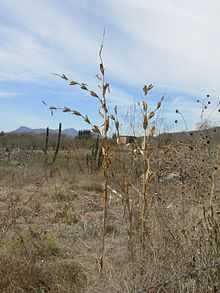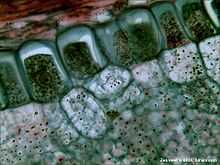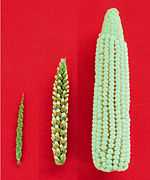Zea (genus)
| Zea | |
|---|---|
 | |
| Teosinte (Zea mays ssp. parviglumis) | |
| Scientific classification | |
| Kingdom: | Plantae |
| (unranked): | Angiosperms |
| (unranked): | Commelinids |
| Order: | Poales |
| Family: | Poaceae |
| Subfamily: | Panicoideae |
| Tribe: | Andropogoneae |
| Genus: | Zea |
| Species | |
| Synonyms | |
| |
Zea is a genus of true grasses in the family Poaceae. Several species are commonly known as teosintes and are found in Mexico, Guatemala, and Nicaragua.
There are five recognized species in the genus: Zea diploperennis, Zea perennis, Zea luxurians, Zea nicaraguensis, and Zea mays. The last species is further divided into four subspecies: huehuetenangensis, mexicana, parviglumis, and mays. The first three subspecies are teosintes; the last is maize, or corn, the only domesticated taxon in the genus Zea. The species are grouped into two sections, sect. Luxuriantes, with the first four species, and sect. Zea with Zea mays. The former section is typified by dark-staining knobs made up of heterochromatin that are terminal on most chromosome arms, while most subspecies of sect. Zea may have 0 to 3 knobs between each chromosome end and the centromere and very few terminal knobs (except Z. m. huehuetenangensis which has many large terminal knobs). The two perennials are thought to be one species by some.
Description

There are both annual and perennial teosinte species. Zea diploperennis and Z. perennis are perennial, while all other taxa are annual. All species are diploid (n=10) with the exception of Z. perennis, which is tetraploid (n=20). The different species and subspecies of teosinte can be readily distinguished based on morphological, cytogenetic, protein, and DNA differences and on geographic origin, although the two perennials are sympatric and very similar. What many consider to be the most puzzling teosinte is Z. m. huehuetenangensis which combines a morphology rather like Z. m. parviglumis with many terminal chromosome knobs and an isozyme position between the two sections. Considered to be phenotypically the most distinctive, as well as the most threatened, teosinte is Z. nicaraguensis. This teosinte thrives in flooded conditions along 200 meters of a coastal estuarine river in northwest Nicaragua.
Teosintes strongly resemble maize in many ways, notably their tassel (male inflorescence) morphology. Teosintes are distinguished from maize most obviously by their numerous branches each bearing bunches of distinctive, small female inflorescences. These spikes mature to form a two-ranked 'ear' of five to ten triangular or trapezoidal, black or brown disarticulating segments, each with one seed. Each seed is enclosed by a very hard fruitcase, consisting of a cupule or depression in the rachis and a tough lower glume. This protects them from the digestive processes of ruminants that forage on teosinte and aid in seed distribution through their droppings. Teosinte seed exhibits some resistance to germination but will quickly germinate if treated with a dilute solution of hydrogen peroxide.
Origin of maize and interaction with teosintes

Teosintes are critical components of maize evolution, but opinions vary about which taxa were involved. According to the most widely held evolutionary model, the crop was derived directly from Z. m. parviglumis by selection of key mutations;[3] up to 12% of its genetic material came from Z. m. mexicana through introgression. Another model proposes that a tiny-eared wild maize was domesticated, and after being spread from east-central Mexico, this cultigen hybridized with Z. luxurians or Z. diploperennis resulting in a great explosion of maize genetic diversity, ear and kernel forms, and capacity to adapt to new habitats, as well as increased yields. A third model suggests that the early maize resulted from a cross between Z. diploperennis and a species of Tripsacum; support for this is minimal[citation needed] . A fourth model posits that teosinte resulted from hybridization between an early wild form of Z. m. mays and Tripsacum.[4]
All but the Nicaraguan species of teosinte may grow in or very near corn fields, providing opportunities for introgression between teosinte and maize. First- and later-generation hybrids are often found in the fields, but the rate of gene exchange is quite low. Some populations of Z. m. mexicana display Vavilovian mimicry within cultivated maize fields, having evolved a maize-like form as a result of the farmers' selective weeding pressure. In some areas of Mexico, teosintes are regarded by maize farmers as a noxious weed, while in a few areas farmers regard it as a beneficial companion plant, and encourage its introgression into their maize.
Ecology
Zea species are used as food plants by the larvae (caterpillars) of some Lepidoptera species including (in the Americas) the Fall Armyworm (Spodoptera frugiperda) the Corn Earworm (Helicoverpa zea), and the stem borers Diatraea and Chilo; in the Old World, it is attacked by the Double-striped Pug, the cutworms Heart and Club and Heart and Dart, the Hypercompe indecisa, the Rustic Shoulder-knot, the Setaceous Hebrew Character and Turnip Moths, and the European Corn Borer (Ostrinia nubilalis), among many others.
Virtually all populations of teosinte are either threatened or endangered: Zea diploperennis exists in an area of only a few square miles; Zea nicaraguensis survives as approx. 6000 plants in an area 200 x 150 meters. The Mexican and Nicaraguan governments have taken action in recent years to protect wild teosinte populations, using both in-situ and ex-situ conservation methods. There is currently a large amount of scientific interest in conferring beneficial teosinte traits, such as insect resistance, perennialism and flood tolerance, to cultivated maize lines, although this is very difficult due to linked deleterious teosinte traits.
Species
- Zea diploperennis H.H.Iltis et al.
- Zea luxurians (Durieu & Asch.) R.M.Bird
- Zea mays L.
- Zea mays subsp. huehuetenangensis (H.H.Iltis & Doebley) Doebley
- Zea mays subsp. mays – Maize, Corn
- Zea mays subsp. mexicana (Schrad.) H.H.Iltis
- Zea mays subsp. parviglumis H.H.Iltis & Doebley
- Zea nicaraguensis H.H.Iltis & B.F.Benz
- Zea perennis (Hitchc.) Reeves & Mangelsd.[1]
Notes and references
- ↑ 1.0 1.1 "GRIN Species Records of Zea". Germplasm Resources Information Network. United States Department of Agriculture. Retrieved 2010-11-06.
- ↑ "Genus: Zea L.". Germplasm Resources Information Network. United States Department of Agriculture. 2007-02-16. Retrieved 2010-11-06.
- ↑ Matsuoka, Y.; Vigouroux, Y; Goodman, MM; Sanchez G, J; Buckler, E; Doebley, J (2002). "A single domestication for maize shown by multilocus microsatellite genotyping". Proceedings of the National Academy of Sciences 99 (9): 6080. doi:10.1073/pnas.052125199. PMC 122905. PMID 11983901.
- ↑ Paul. C. Mangelsdorf: Corn: Its Origin, Evolution and Improvement, Belknap Press, 1974
External links
| Wikimedia Commons has media related to Zea. |
| Wikispecies has information related to: Zea |